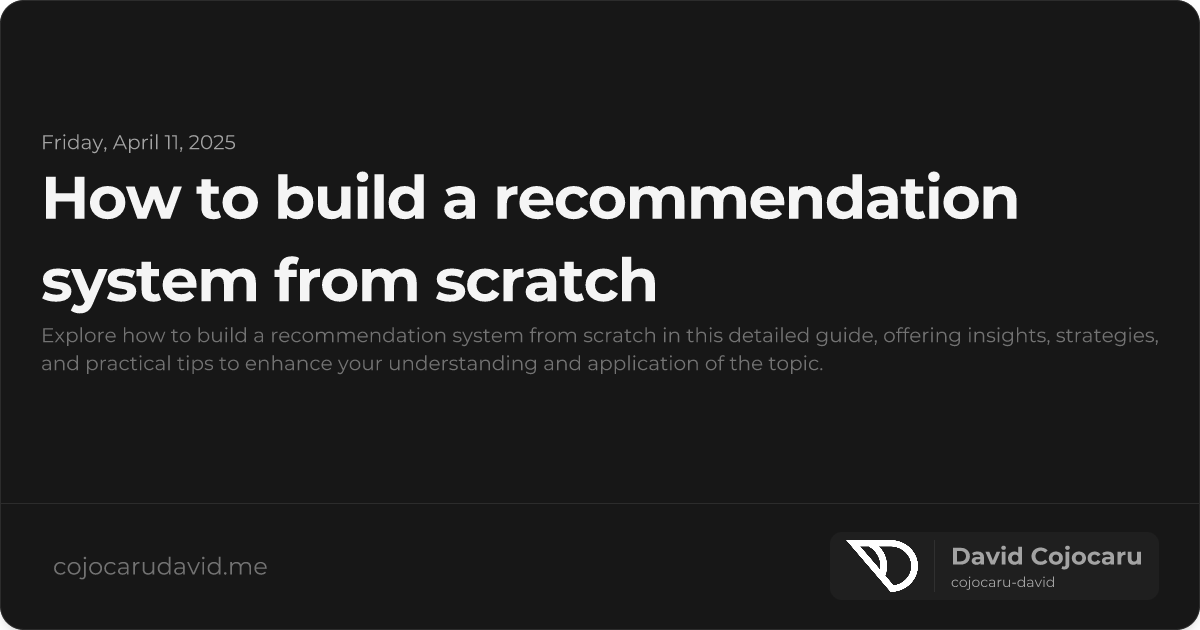Build Your Own Recommendation System: A Step-by-Step Guide
Recommendation systems are the unsung heroes of personalized online experiences, quietly powering platforms like Netflix, Amazon, and Spotify. Ever wondered how they suggest the perfect movie, product, or song? Learning how to build a recommendation system from scratch is a highly sought-after skill for data scientists and developers. This comprehensive guide will walk you through the essential steps, algorithms, and best practices to create your very own recommendation engine.
Understanding the Fundamentals of Recommendation Systems
Recommendation systems work by predicting user preferences, tailoring suggestions based on past behavior, similarities between users, or the intrinsic attributes of items. There are three core types of recommendation systems:
-
Collaborative Filtering: This method leverages user interactions (like ratings, purchases, or clicks) to recommend items. Think “users who liked this also liked…”
-
Content-Based Filtering: This approach suggests items that are similar to those a user has shown interest in before. It focuses on the features and characteristics of the items themselves.
-
Hybrid Models: These systems combine collaborative and content-based filtering to leverage the strengths of both and achieve higher accuracy and robustness.
Each method offers unique advantages and disadvantages, which we will delve into in more detail.
Step 1: Gathering and Preparing Your Data
Before you can build a powerful recommendation engine, you need a solid foundation of structured data. Common datasets used for this purpose include:
- User Ratings (e.g., the classic MovieLens dataset provides movie ratings from various users)
- Purchase History (tracking what users have bought)
- Browsing Behavior (analyzing user clicks and page views)
Once you have your data, preprocessing is crucial. Key steps include:
- Handling Missing Values: Decide how to deal with missing data points. You can impute them using statistical methods or remove incomplete entries.
- Normalizing Ratings: Scale ratings to a common range (e.g., between 0 and 1) to prevent certain users or items from disproportionately influencing the results.
- Encoding Categorical Features: Convert categorical data (like movie genres or product categories) into numerical representations using techniques like one-hot encoding.
Step 2: Choosing and Implementing the Right Algorithm
Collaborative Filtering with Matrix Factorization
Matrix factorization is a powerful technique that decomposes the user-item interaction matrix into latent factors, revealing underlying relationships. Here’s a basic implementation using Python and Singular Value Decomposition (SVD):
import numpy as np
from scipy.sparse.linalg import svds
# User-item matrix (rows: users, columns: items), with 0 representing missing ratings
R = np.array([[5, 3, 0, 1], [4, 0, 0, 1], [1, 1, 0, 5], [0, 0, 0, 4]])
U, sigma, Vt = svds(R, k=2) # k = number of latent factors (adjust as needed)
predicted_ratings = np.dot(np.dot(U, np.diag(sigma)), Vt)Explanation: This code snippet demonstrates how to use SVD to predict missing ratings. The k parameter controls the number of latent features, influencing the model’s complexity and performance. Experiment with different values of k to find the optimal setting for your data.
Content-Based Filtering
For content-based recommendation systems, leverage techniques like TF-IDF (Term Frequency-Inverse Document Frequency) or word embeddings to quantify the similarity between items based on their descriptions or attributes. Here’s an example using TF-IDF and cosine similarity:
from sklearn.feature_extraction.text import TfidfVectorizer
from sklearn.metrics.pairwise import cosine_similarity
documents = ["action movie with explosions", "hilarious comedy film", "mind-bending sci-fi adventure"]
vectorizer = TfidfVectorizer()
tfidf_matrix = vectorizer.fit_transform(documents)
similarity = cosine_similarity(tfidf_matrix[0], tfidf_matrix) # Similarity of the first document with all othersExplanation: This code calculates the cosine similarity between the first document and all others in the documents list. TF-IDF converts the text descriptions into numerical vectors, allowing for similarity calculations. You can then recommend items with the highest similarity scores.
Step 3: Evaluating the Performance of Your Model
Rigorous evaluation is essential to ensure your recommendation system is providing accurate and relevant suggestions. Key metrics to consider include:
-
RMSE (Root Mean Squared Error): Measures the difference between predicted and actual ratings, suitable for rating prediction tasks. Lower RMSE indicates better accuracy.
-
Precision@K: Measures the proportion of relevant items within the top-K recommendations. This is useful for evaluating ranking performance.
-
A/B Testing: Compare user engagement metrics (e.g., click-through rates, conversion rates) with different recommendation models to determine which performs best in a real-world setting.
Step 4: Deploying Your Recommendation System
Once you have a well-trained and evaluated model, the next step is deployment. Consider these options:
-
Flask/Django: Use these Python web frameworks to create lightweight APIs for serving recommendations.
-
TensorFlow Serving: A robust and scalable platform for deploying machine learning models, particularly those built with TensorFlow.
-
Cloud Platforms: Leverage cloud-based machine learning services like AWS SageMaker or Google AI Platform for easy deployment and scaling.
Conclusion: Your Journey to Personalized Recommendations
Building a recommendation system from scratch requires careful data preparation, thoughtful algorithm selection, and continuous evaluation. Whether you opt for collaborative filtering, content-based methods, or a hybrid approach, the key lies in iterative improvement and a deep understanding of your data and users.
“The best recommendation systems don’t just predict what users want; they anticipate their unspoken needs and surprise them with delightful discoveries.”
Start small, experiment with different techniques, and continuously refine your model to deliver truly personalized and engaging experiences at scale. Good luck!

